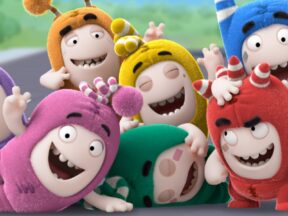

The Art Of The Acquisition: Moonbug Managing Director Andy Yeatman On What His Company Looks For In An IP
Moonbug has become a leader in the animation industry by making shrewd, well-planned acquisitions and growing independent animated properties into global franchises.
The company made its name with titles like Cocomelon, Blippi, Morphle, and the recently acquired Oddbods, turning them into household names.
But what makes a property attractive to a company like Moonbug? What criteria are media companies looking for when thinking about picking up an independent IP from an individual or small group of individuals? And what should independent creators know that may help their property in the long run?
Moonbug Managing director Andy Yeatman, a former Disney and Netflix employee, recently spoke with us about those difficult questions, his company’s core values, the inner workings of an acquisition, and much more. We began by talking about what Moonbug needs to see in a property before an acquisition can even be considered.
Popularity
For any property to catch the eye of Moonbug, or almost any other big media company for that matter, it needs to have an audience.
“We look at different metrics, but ultimately engagement is kind of the biggest thing,” explained Yeatman. “The size of the audience is important, but we look at the watch time and how the audience is engaging. Are they coming back?”

According to Yeatman, Moonbug considers two key metrics when looking at a new IP, awareness and affinity. For Moonbug, awareness is purely statistical, as in how many people are watching. Affinity is a bit harder to gauge, but Yeatman says it can be boiled down to “Do people love the show? Are they passionate about it?”
Core Values
“The second thing we consider is: Does the property have certain core values that fit our curriculum?”
Examples provided by Yeatman included major topics such as social and emotional life skills development down to simple everyday things like brushing your teeth, eating your vegetables, or cleaning your room.
A Franchise for the Future
“The third consideration is if we think a property can be a true franchise for the future. Is this just a flash in the pan? Or is it something that can be built around for years to come?”
When Moonbug is considering the future of a property, it’s thinking in years and decades, not weeks and months. This criteria is one reason why core values are so important in any IP because those themes tend to be timeless. For a franchise to have a future, it needs to possess Yeatman’s fourth criteria…
Room for Growth
The first thing Moonbug considers when checking out a property is its popularity. That being said, an IP can be too popular for Moonbug if the company doesn’t see room for fairly significant growth.
“The fourth thing we consider is if we believe we can really grow a property,” said Yeatman. “We want to grow our acquisitions three-to-five times over a five-year period. So, our bread and butter is usually IP which was independently created, has been around for years, has built up its audience, and is produced by a small team. It’s also usually only on one or two platforms so we know we have new areas where we can grow them.”
Moonbug grows its properties in several different ways. Merchandising is the most obvious, but Yeatman discussed publishing, music, podcasts, live shows, and more when talking about seeing potential in an IP.
“We need to see something beyond the core show because otherwise, it’s unlikely we’ll see that three-to-five times growth we’re looking to create,” he explained.

Behind Every Acquisition
For Moonbug, each acquisition is unique in many ways, but certain characteristics hold for all of them.
“Every acquisition is emotional at times,” said Yeatman. “Every one is the biggest decision of the creator’s career. Because of that, they often take months or years to finalize. So, we really have to get to know the creators and structure the deal around what they want to do.”
“Every property that we’re a part of at Moonbug someone started doing it while they still had a day job. They started making content, putting it out there, paying close attention to what they heard from the audience, and adapting to that. And then, over many weeks, months, and years, created something with a large, passionate audience.”
After an Acquisition
Moonbug’s biggest acquisitions usually end up finding homes on linear tv, streaming platforms, and digital channels. But when an acquisition is new and the company is still building up an audience, platforms that allow Moonbug to distribute its content directly to the consumer are preferred.
“Our strategy is to have a direct connection with the consumer. In our case, that’s typically through Youtube first,” Yeatman explained. “So initially, there is no gatekeeper. We don’t have to work with Netflix or Disney or Sky right away. We certainly want to, and that’s part of our long-term strategy, but it’s helpful that it’s not something we must do to get these properties to their audiences.”
A Bit of Advice
When asked for a word of advice for independent web-based creators looking to grow their IP, Yeatman pointed out that Moonbug has inherited its share of bad deals with some of its acquisitions. He says that creators should be careful of deals that would take creative control away from the property’s creators, but recognized that sometimes in order to grow, a property needs to take on partners.
With his answer, Yeatman explained that sometimes “it’s easy to say ‘That was a bad deal’ when looking back five years. But when you’re just a year in and someone offers you money and the chance to make some merchandise, it might have made sense at the time. As long as your partner is going to help grow awareness and affinity and you haven’t lost creative control, then I think it depends on the situation.”
According to Yeatman, There is no one-size-fits-all strategy that creators can follow to create a successful property with commercial value. It’s worth keeping an eye out for red flags, but at some point, risks will need to be taken.




